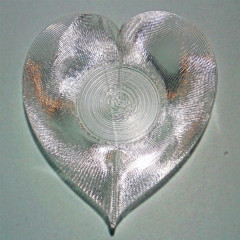Kanada, Y., Artificial Life and Robotics, Vol. 19, No. 4, pp. 311-316, November 2014, http://dx.doi.org/10.1007/s10015-014-0182-9
[ 日本語のページ ]
[ Springer's page (preprint) ]
[ Paper (draft) ]
[ Original paper (ISAROB 2014) ]
[ Printing process (YouTube) ]
 Abstract: 3D printing technology usually aims at reproducing objects deterministically designed by 3D CAD tools; however, the author has discovered that 3D printing can also generate self-organizing patterns similar to stochastic (or randomized) 1D cellular automata (CA). A method for generating patterns similar to randomized 1D or 2D CA by using a fused deposition modeling 3D printer is thus proposed. With constant head motion and constant filament extrusion and without explicit randomness, this method generates very fine emergent patterns with natural fluctuation. By means of this method, each time a different pattern is generated. In addition, a computational CA model that simulates the above process is also proposed. The proposed method will open a new horizon of 3D printing applications.
Abstract: 3D printing technology usually aims at reproducing objects deterministically designed by 3D CAD tools; however, the author has discovered that 3D printing can also generate self-organizing patterns similar to stochastic (or randomized) 1D cellular automata (CA). A method for generating patterns similar to randomized 1D or 2D CA by using a fused deposition modeling 3D printer is thus proposed. With constant head motion and constant filament extrusion and without explicit randomness, this method generates very fine emergent patterns with natural fluctuation. By means of this method, each time a different pattern is generated. In addition, a computational CA model that simulates the above process is also proposed. The proposed method will open a new horizon of 3D printing applications.
Introduction to this research theme: 3D shape formation technologies
